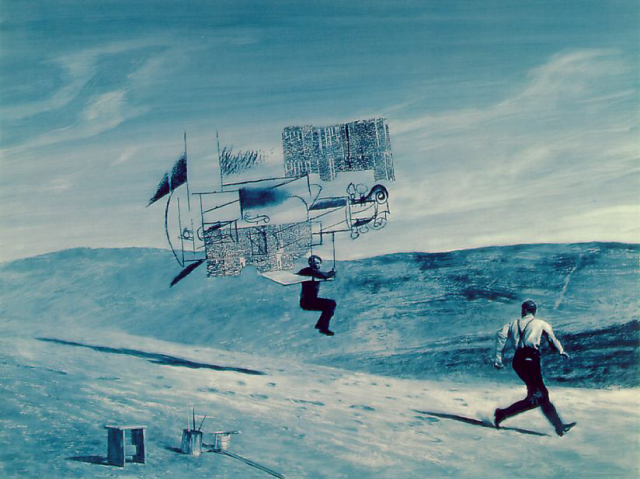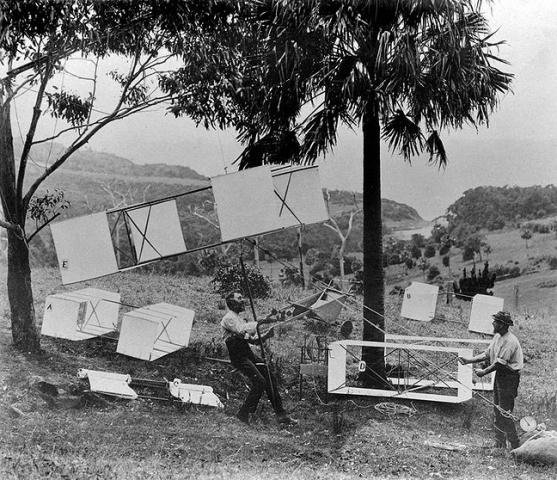David M. Rieder: Programming Is the New Ground of Writing
David M Rieder, North Carolina State University

Figure 1. Mark Tansey’s Picasso and Braque
There are three reasons that I’m beginning this presentation with Mark Tansey’s painting, Picasso and Braque (see Figure 1 above).

First, the painting is reminiscent of Orville and Wilbur Wright’s first successful flight in Kill Devil Hills, North Carolina, which is just a few hours drive from the site of this conference. Second, at a conference on writing, many of Tansey’s paintings, including this one, celebrate text in one way or another—especially the printed word. In the painting above, Picasso is flying one of his collages, while Braque surveys his progress from the ground. The point related to Tansey’s interest in the printed word is that the flying surfaces of Picasso’s collage are made from swaths of newsprint. Arguably, his flying machine is a multimodal writing machine—albeit a curious-looking one because it appears to be more of a combination of kite and plane. It may be more accurate to say it’s a machine made from what look like Hargrave cells wrapped in words. Juxtaposed against the photograph below (see Figure 2), Tansey’s painting is a bit of a mash-up of histories of flying, Hargrave’s kites and the Wrights’ plane.

Figure 2. Wikipedia image of Hargrave (left) and Swain
But, getting back on track, in addition to these two points is the third, which includes my main point. In Tansey’s painting, the words printed on the swaths of newsprint, the writing, has broken free of its logocentric grounding. It’s a relative break (not an absolute deterritorialization) because the writing on those swaths of newsprint is still recognizable as writing—but the words have taken on a value relative to the flying machine that they serve. The words are still readable, but the point here is why bother reading them?

Or, rather (I don’t really mean to throw the baby out with the bathwater), why limit their value to their readability? The flying machine, the dynamic medium they now serve, invites us to step away from our conventional stance toward writing, which is writing at a standstill, and unground ourselves.

In computational media, writing wants to take a walk, not sit on a couch to be analyzed.1 Writing doesn’t need to be limited to the faithful representation of the spoken word—it never did, in fact. In computational media, our alphabet is motivated and dynamic. As Richard Lanham explains in The Economics of Attention, it is capable of thinking. In digital media, writing has expanded far beyond the limits of the logocentric tradition, but many of us continue to reinforce it in our teaching. In a comparison of print and digital textuality, Lanham explains that “all of our attention goes to the meaning of the text” in print-based media (81-2). But when text is digitized, meaning is less important than the ways in which it can move and be transformed. When it comes to computational media and the topic of this town hall, if writing can think (i.e., if it is mobile and transformable) then we should turn our focus away from content, which has diminishing value, to algorithmic forms and functions, which are the stasis of meaning in today’s attention economy.
So, my third point about Tansey’s painting, what I like about it, is that we’re all Picasso in flight, whether we know it or not.

How many of us were multi-tasking with tablets or laptops during the Computers and Writing conference, partly here, partly somewhere else? We’re in flight right now. But here’s the problem, or rather the challenge: while we’re all comfortable in flight, far fewer of us are willing or able to recognize how writing has taken flight, too.
The new ground, the new basis of writing is algorithmic. Today, the power and profit in writing has less to do with representing speech than serving a computationally-driven, generative process of creation. If you are teaching and practicing writing as a grounded, representational technology, you are missing the proverbial forest for the trees, the machine for the pages of newsprint.

I hope you’ll forgive the next and final provocation, which I fear smacks of what Jill Morris might characterize as the turn from geek to jerk, but, if you can’t write code, if you can’t think with code, if you can’t write algorithmically, you may eventually find yourself stuck in the logocentric sands of the past.2

Notes
1 In the opening pages of Anti-Oedipus, Gilles Deleuze and Felix Guattari write, “A schizophrenic out for a walk is a better model than a neurotic lying on the analyst’s couch” (2).
2In her presentation at Computers and Writing, Jill Morris reprimanded the geeks in the gaming community whose condescensions about insider know-how made them out to be jerks.